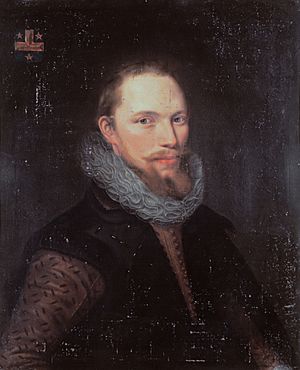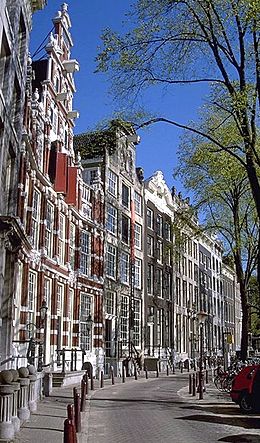Michael Reyniersz Pauw facts for kids

Michiel Reiniersz Pauw (born March 29, 1590, in Amsterdam; died March 20, 1640, in Ghent) was an important person in Amsterdam. He served as a burgemeester, which is like a mayor or city leader. He was also a director of the Dutch West India Company (WIC).
Contents
Who Was Michiel Pauw?
Michiel Pauw was born into a wealthy merchant family in Amsterdam. His father, Reinier Pauw, was not only a merchant but also a mayor of Amsterdam. Michiel studied law in Leiden, a city in the Netherlands.
His brother, Adriaan Pauw, was also a very important person. He was the Grand Pensionary of Holland, which was a top political job, from 1631 to 1636 and again from 1651 to 1653. Adriaan also helped sign the Peace of Münster in 1648, which ended a long war.
Exploring New Netherland
The Dutch West India Company (WIC) was started in 1621. Its main goal was to trade in the Western Hemisphere, which includes North and South America. By 1625, the company had set up colonies in places like Fort Amsterdam (now Lower Manhattan in New York City) and Fort Orange.
The Patroon System
To encourage more people to move to these new lands, the WIC started a special program in 1629. They offered huge pieces of land and a special title called "patroon." A patroon was like a landlord who owned a large area and had certain rights and duties, almost like a feudal lord from older times. This system was part of something called the Charter of Freedoms and Exemptions.
Pavonia: A New Colony
In 1630, Michiel Pauw bought two large areas of land from the Lenape people. These areas were called Hopoghan Hackingh (Hoboken) and Ashasimus (Harsimus). This land covered the entire peninsula between the Hudson River and Hackensack River, which is now known as Hudson County, New Jersey. He also bought Staten Island, which is now part of New York City.
Pauw named his patroonship "Pavonia." This name comes from the Latin word for "peacock," which is what his last name, Pauw, means. It's believed that the Manhattans, a Native American group, sold Staten Island to him after they had sold their home island to Peter Minuit a few years earlier.
At first, a small hut and a ferry landing were built at a place called Arresick, which was also known as Powles Hoek (Paulus Hook). However, Pauw did not meet all the conditions set by the WIC. He was supposed to bring at least fifty adult settlers to the area. Because he didn't do this, he had to sell his land back to the company.
In 1634, Michiel Pauw worked with Kiliaen van Rensselaer and Wouter van Twiller. They sent cattle, including horses and cows, to the new colonies over the next six years.
Pavonia's Legacy Today
Even though Michiel Pauw didn't keep his patroonship, the name Pavonia is still used today. You can find Pavonia Avenue and a library branch in Jersey City. There's also a Pavonia Court in Bayonne and another Pavonia Avenue in Kearny. The Erie Railroad's old train station on the Hudson waterfront was called Pavonia Terminal. The PATH train system also had a station once called Pavonia.
Saint Peter's College, which is built on land that was once part of the patroonship, has a peacock as its mascot. This is a nod to Michiel Pauw's name.
Island Named After Him
Pavonia was not the only place named after Michiel Pauw. The Fernando de Noronha Archipelago is a group of islands off the coast of Brazil. It was first described by Amerigo Vespucci in 1503. Over the years, different countries tried to control it.
In 1628, the Dutch took over the islands. They lost them two years later but occupied them again in 1635. The Dutch used the island as a hospital for their soldiers who were fighting in Northeastern Brazil. During this time, the island became known as Pavonia, in honor of Michiel Pauw. The Dutch controlled the island for almost twenty years before Portugal took it back.
A Successful Merchant's Home
Michiel Pauw was clearly a very successful person. He was able to hire a famous architect of his time to build a beautiful grachtenpand, which is a canal house, in Amsterdam. This house can be seen in the first two pictures at the top of this article. It was built with white sandstone brought from Germany. It was also the first house in Amsterdam to have a special "neck" gable design on its roof.
See also
 In Spanish: Michiel Pauw para niños
In Spanish: Michiel Pauw para niños



